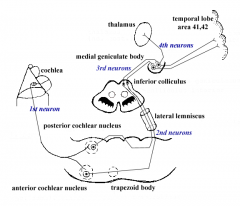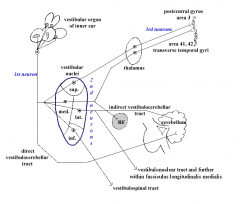![]()
![]()
![]()
Use LEFT and RIGHT arrow keys to navigate between flashcards;
Use UP and DOWN arrow keys to flip the card;
H to show hint;
A reads text to speech;
38 Cards in this Set
- Front
- Back
|
Sensory innervation of auricula
|
Sensory innervation
-nn. auriculares ant. from n. auriculotemporalis (superior -anterior 2/3) -n. auricularis post. -r. auricularis n. X. (concha + meatus) – irritation of n.X |
|
|
Meatus acusticus externus
- Constists of what? |
outer 2/3 – cartilage opened ventrocaudally (incisurae), lamina tragi (ventrally)
inner 1/3 – bone |
|
|
Where is paracentesis done?
|
Paracentesis: lower dorsal quadrant
|
|
|
Tympanic cavity is drained by what lymphnodes?
|
retropharyngei
|
|
|
Sensory innervation of tympanic cavity? (3)
|
1. n. tympanicus (n.IX)
2. r. pharyngeus (V2) for cartilagineous aprt of tuba auditiva 3. sympathetic - nn. caroticotympanici |
|
|
Ossicula aditus cosists of which bones?
|
Hammae (malleus)
Anvil (incus) Stirrup (stapes) |
|
|
What ligament in tympanic cavity is sensitive to otosclerosis?
|
lig. anulare stapediale
|
|
|
By which nerves are these innervated?
-m. tensor tympani -m. stapedius |
-m. tensor tympani – n.V3
-m. stapedius – n.VII |
|
|
Antrum mastoideum has close relation to what structure?
|
Antrum mastoideum has close relation to sinus sigmoideus
|
|
|
Which muscles opens auditory tube and when?
|
opened in swallowing
(m. tensor tympani (v3)+ m. salpingopharyngeus) |
|
|
What can be found in the bony labyrith?
|
porus acusticus internus - beginning
fundus meatus acustici interni - end -crista transversa + verticalis -area n. VII. -area cochlearis – tractus spiralis foramisosus -area vestibularis sup. + inf. -foramen singulare |
|
|
What can be found in the membraneus labyrith?
|
Utriculus + Sacculus
-Maculae (otholits CaCO3) – linear movements Ductus semicirculares (ampullae, crura) - Crista ampullaris – angular acceleration Ductus utriculosaccularis, reuniens Ductus + saccus endolyphaticus Ductus cochlearis |
|
|
Auris interna
– blood supply -Lymph |
-a. basilaris -> a. inf. ant. cerebelli -> a. labyrinthi
(Vasodilating drugs) -Lymph: replaced with endo- and perilympha |
|
|
Auris interna - nerves (4)
|
1.Nervus vestibularis
– ggl. vestibulare Scarpae -n. utriculoampullaris, saccularis, ampullaris posterior 2. Nervus cochlearis – ggl. cochleare Corti 3. angulus pontocerebellaris - with n. VII 4. neurinom of n. VIII |
|
|
Auditory pathway
-How many neurons? -Describe the pw |

4-neuron crossed pathway)
1st neuron: bipolar cell in the ganglion cochleare - n. cochlearis - n. VIII - the pathway is divided in two parts and continues to cochleares nuclei 2nd neuron: cells in the nucleus cochlearis posterior (axons continue as striae medulares ventriculi quarti and submerge in the median sulcus) et anterior (axons pass deep in the matter of myeencephalon through trapezoid body), their axons meet and join in the lemniscus lateralis and enter the colliculus inferior 3rd neuron: cells in the colliculus inferior 4th neuron: cells in the corpus geniculatum mediale , axons radiate in the thalamus and in the lobus temporalis - gyrus temporalis transversus Heschli, area 41, 42 |
|
|
Vestibular pathway
-How many neurons? -Describe pw |

3-neuron crossed pathway
1st neuron: bipolar cells in the ganglion vestibulare - n. vestibularis - n.. VIII (some fibres form tractus vestibulocerebellaris directus pasnig without any interpolation to the cerebellum) 2nd neuron: cells in the nuclei vestibulares pontis, their axons radiate to various structures (interpolated fibres as the tractus vestibullaris indirectus to the cerebellum, tractus vestibulospinalis to the medulla spinalis, tractus vestibulonucleares to the nuclei of cranila nerves, fasciculus longitudinalis medialis, and tracts to the reticoular formation and thalamus) 3rd neuron: cells in the nuclei ventrales thalami - to brain cortex (lobus temporalis, area 41,42 - gyrus temporalis transversus /Heschl/, lobus parietalis - area 3, gyrus postcentralis |
|
|
Development of auris media
-When is antrum mastoideum formed? |
antrum mastoideum
-cellulae mastoideae are formed in 2nd year |
|
|
What is done before hearing test?
|
Before testing:
Otoscopy Mikrootoscopy |
|
|
What is part of the Conductive Part of hearing?
(Conductive Hearing Loss) |
External Ear
- Middle Ear – Tympanic Membrane Ossicles - Liquid Filled Space |
|
|
What is part of the Perceptive Part ? (Sensorineural Hearing Loss )
What is the hearing loss of each part called? |
Perceptive Part = Sensorineural Hearing Loss (H.L.)
- Organ of Corti = Cochlear H.L. - Auditory Nerve = Neural H.L. - Hearing Pathway = Supracochlear H.L. - Cerebral Cortex = Central H.L. |
|
|
Subjective Tests of Hearing without Special Devices
|
-Whispering x Conversational Speech
-Tuning Force Weber´s Rinne´s Schwabach Gelle |
|
|
Tests of Hearing Subjective
Hearing Thresholds What is tested? -Machines operates with which frequencies? |
Hearing Thresholds
- Air Conduction Thresholds - Bone Conduction Thresholds Audiometer – Electronic Instrument Generate Pure Tone Frequency 125 – 8000 Hz |
|
|
Tests of Hearing Subjective
Speech Audiometry -Which are the thersholds of understanding? |
Speech Audiometry – Determined Understanding Highly Usefful for Diagnosis.
Special Words from CD 50 % Correctly understood Word = Speech Receptual Thershold 100 % Correctly understanding Word = 100 % Speech Discrimination |
|
|
Tests of Hearing Objective
Impedance Measuremant -which are the different types and what do they test? -What els is tested? |
TYMPANOMETRY
A Tympanogram = Normal Middle Ear and Eardrum B Tympanogram = Fluid in the Middle Ear C Underpressure in the Tympanic Cavity STAPEDIUS REFLEX Changes: Present x Notpressent Decay |
|
|
Test of Hearing Objective
ERA – Evoked Response Audiometry -What is it? -Which parts are tested and what is it called? |
Registration Electrical Charges Generated on Presentation of Sound
in Cochlea ( Cochleography ) In Brainstem ( BERA, BAEP ) In Cortex ( CERA ) |
|
|
Test of Hearing Objective
OAE – Otoakustic Emission -What is it? -When is it done? |
The Ear, when stimulated can emit Sound (prof.Kemp).
This Sound can be Measured when Hearing is Normal Usefful in Screening of Infants (Newborns) |
|
|
Therapy
-Cerumen |
Cerumen:Preferency of Otomikroscopic Menagement
|
|
|
Therapy
-Sekretoric otitis |
Sekretoric otitis:
endoskopic adenotomy Transmyringing Drainege (Tubes) |
|
|
Therapy
-Chronic Otitis, otosklerosis |
Chronic Otitis, otosklerosis:
Otosurgery (Excelent Results ) |
|
|
Therapy
-Deafnes: |
Deafnes: Cochlear Implants (Condition: Functional Auditory Nerve)
|
|
|
Therapy
-Sudden Hearing Loss |
Sudden Hearing Loss: Corticoids + Vasoactive Drug Imidiately (in 24 hours)
|
|
|
Therapy
-Progressive Sensorineural H.L. |
Progressive Sensorineural H.L.: Binaural Hearing Aids (Digital)
|
|
|
Summary of hearing testing and therapy?
-GP -ENT -Therapy |
G.P: Otoscopy
Whisper and Normal Speech Tuning Fork ENT: Audiometry: Bone and Air Conduction Thresholds Speech Audiometry Objective Audiometry Impedance Measurment (Tympanometry + Stapedius rfl.) Evoked Potentials, OAE Therapy: Digital Hearing Aids Cochlear Implant |
|
|
Diagnostic protocol for tinitus
|
Subjective data - patient´s evaluation of tinnitus, history
Otomicroscopy Audiometry-vestibulometry: PTA, SA BERA Tinnitometry - intensity (dB) and frequency (Hz) Facultative/additional: ENG, calorimetry, rotatory tests, CCG, CPG Complementary Examinations: Neurology Internal Labs X-ray (CT, NMR), etc. |
|
|
Type of hearing loss (tinnitus combined with hearing loss in 75 %):
apicocochlear: basocochlear: pancochlear: |
apicocochlear: 4 %
basocochlear: 50 % pancochlear: 21 % |
|
|
Therapeutic Methods tinnitus
Most used combinations: |
PTXF (Vinca Minor) + RHB
LIDOCAIN + RHB |
|
|
Therapeutic methods (9)
|
Pharmacotherapy
Rehabilitation of cervical spine Soft technics, postisometric relaxation, mobilisation, exercise Laser Surgery (IEC) Hyperbaric oxygenation Psychoterapy Alternative (acupuncture),Chinese Medicine Combined therapy |
|
|
Is it worth treating tinnitus?
What treatment is the most effective? What is most effective in acute tinnitus? What is most effective in chronic tinnitus? |
According to results is worth to treat both chronic and acute tinnitus
Most effective is combination of methods In acute tinnitus treatment was the most effective Pentoxiphyllin In chronic tinnitus treatment was the most effective Corticosteroids |

